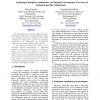Free Online Productivity Tools
i2Speak
i2Symbol
i2OCR
iTex2Img
iWeb2Print
iWeb2Shot
i2Type
iPdf2Split
iPdf2Merge
i2Bopomofo
i2Arabic
i2Style
i2Image
i2PDF
iLatex2Rtf
Sci2ools
HICSS
2007
IEEE
2007
IEEE
Analyzing Enterprise Architecture in National Governments: The Cases of Denmark and the Netherlands
National enterprise architectures (NEA) promise to fill the gap between policy and implementation. NEAs are embedded within an institutional environment consisting of active players capable of responding strategically and innovatively to architectural initiatives, which might complicate NEA adoption. In this paper we analyze the efforts of two European national governments in developing enterprise architecture. Grounded in institutional theory and practice we develop an analytical framework and use this framework to analyze the efforts of two countries, Denmark and the Netherlands. Our framework and analysis draws the attention to the need to take a broader perspective on enterprise architecture, especially governance aspects determine the adoption and diffusion of NEA.
Biometrics | Enterprise Architecture | HICSS 2007 | National Enterprise Architectures | NEA Adoption | System Sciences |
| Added | 02 Jun 2010 |
| Updated | 02 Jun 2010 |
| Type | Conference |
| Year | 2007 |
| Where | HICSS |
| Authors | Marijn Janssen, Kristian Hjort-Madsen |
Comments (0)

